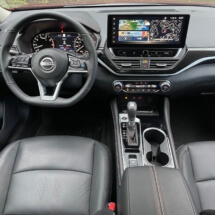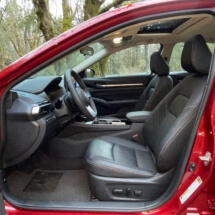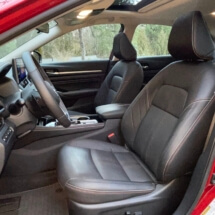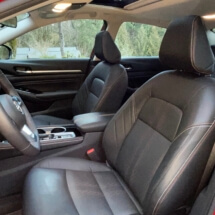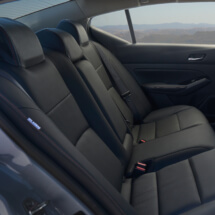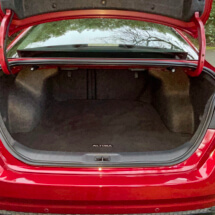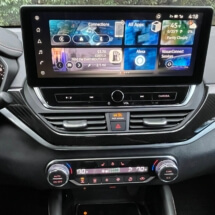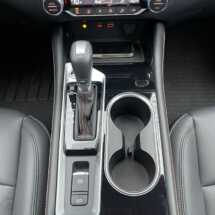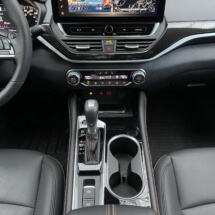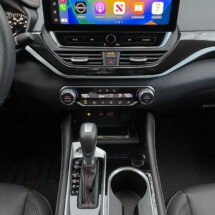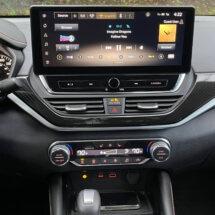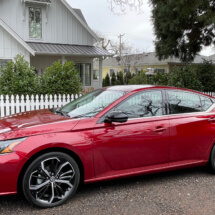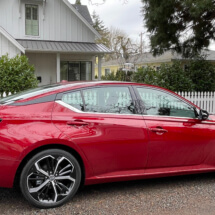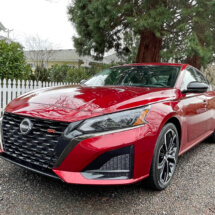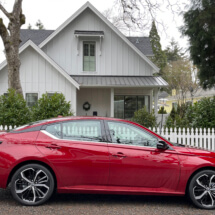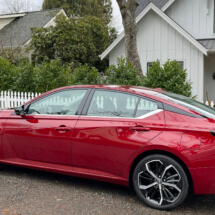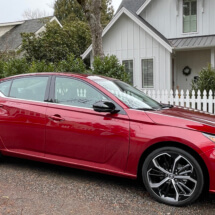Like the Toyota Camry and Honda Accord, the Nissan Altima has long been a competitive midsize sedan. It has a roomy and comfortable cabin, lots of standard features and tech, a user-friendly infotainment system, and good fuel economy. However, its performance isn’t as robust and the cabin isn’t as upscale as what you’ll find in those top contenders.
Base Price: $34,990
As Tested: $36,835
Horsepower: 236
Mileage: 25 mpg city/34 mpg highway/29 mpg combined
The Altima got a makeover for the 2019 model year and is in its sixth generation. There were minimal changes from 2020 through 2022. For 2023, the Altima gets refreshed with updated exterior styling, more standard safety features and tech, and a new larger touchscreen that’s standard on the higher trims.
The 2023 Altima comes in five trims: S, SV, SR, SL and SR VC-Turbo. Starting prices range from $25,290 to $35,190. Front-wheel drive is standard and all-wheel drive is available on the SV, SR and SL trims for $1,500. There’s room for five passengers in two rows of seating.
The four lower trims are powered by a 2.5-liter four-cylinder engine that makes 188 horsepower and 180 pound-feet of torque. My top-of-the-line tester gets a turbocharged 2.0-liter four-cylinder that produces 236 horses and 267 pound-feet. Those increase to 248 hp and 273 pound-feet with 93 octane gas. The transmission is a continuously variable automatic.
The turbo makes for adequate handling. Acceleration is brisk from a stop with just a smidge of turbo lag, and there’s enough oomph for merging and passing at freeway speeds. However, the CVT can be slow to respond at times and can drone when pressed. The Altima feels stable on the road and corners well but the steering has a numb feel. The ride is on the firm side so you will notice some bumps and rough roads.
Fuel economy is good for the class. EPA ratings for my tester are 25 mpg city, 34 mpg highway with a combined rating of 29. I got 28 mpg during my week with a mix of city and highway driving.
The cabin is spacious and comfortable but not as upscale as its rivals. Seats in both rows are supportive and have decent leg- and headroom. Taller passengers will be comfortable up front, and two average-size adults will fit just fine in the back seat.
Standard features include remote keyless entry, remote start, push-button start, rearview camera, cloth upholstery, manually adjustable front seats, analog gauge cluster, infotainment system with seven-inch touchscreen, six-speaker audio system, HD radio, Bluetooth, a USB port, and automatic high-beam headlights.
Available features include a surround-view camera system, proximity keyless entry, dual-zone automatic climate control, leather upholstery, front seats with power adjustments, heated front seats, heated steering wheel, infotainment system with eight-inch touchscreen, infotainment system with 12.3-inch touchscreen, nine-speaker audio system, satellite radio, navigation, Apple CarPlay, Android Auto, three additional USB ports, Wi-Fi hot spot, wireless device charging, and a moonroof.
Standard driver assistance technologies include forward and reverse collision warning with pedestrian detection, forward automatic emergency braking, lane-departure warning, blind-spot monitoring with rear cross-traffic alert, rear parking sensors, driver drowsiness monitoring, and rear seat alert.
Available driver assistance technologies include Nissan’s semi-autonomous driver assistance system which includes adaptive cruise control with lane centering, lane-keep assist, and traffic-sign recognition.
Trunk space is about average for a midsize sedan at 15.4 cubic feet. The rear seats fold down to accommodate longer items.
There are three different infotainment systems. A seven-inch touchscreen is standard on the base S trim. The small screen looks old school with low-res graphics and has no Android Auto or Apple CarPlay. A better eight-inch touchscreen is available, and there’s also a nice 12.3-inch touchscreen. Both are an improvement over the base offering and do have Android Auto and Apple CarPlay. All of the infotainment systems are intuitive and have physical controls for commonly used controls such as audio and climate.
The good:
Roomy cabin
Many standard safety features
Intuitive infotainment system
Good fuel economy
The not-so-good:
Meh performance
Cabin not as upscale as rivals
Android Auto and Apple CarPlay not standard on base trim
Pricing info:
My tester starts at $34,990. Premium paint is $395. Floor mats, trunk mat, hideaway nets and dual trunk hooks are $355. Destination fee is $1,095 bringing the grand total to $36,835.
Bottom line:
Even though sedans aren’t as popular as they once were, this class is full of worthy competitors, including the aforementioned Honda Accord and Toyota Camry, as well as the Hyundai Sonata and Kia K5. The Altima falls a bit short of these but this segment is so competitive that the Altima is still worth a look if you’re shopping for a nice family hauler.


